Aircraft manufacture ticked up in 1921. However, this time the focus was more on military aircraft required for local conflicts, and maintaining self-defense capability.
The United States military developed an interest in winning competitions, and broke the 200-mph barrier. Japan entered the arena as it manufactured its own airplanes for aircraft carriers.
Civilian air transport continued to test its wings by developing local routes, although it focussed on small aircraft while dirigibles did the heavy lifting.
JANUARY 1921
British aircraft carrier HMS Argus returns to service after modifications with windscreens along either side of the deck. These could be raised or lowered to prevent aircraft on the flight deck from blowing, or rolling overboard in heavy weather.
Italian Caproni Ca.60 Achieves a Few Short Hops
The prototype Italian Caproni Ca.60 was an extravagance in a period of abstinence, as the world recovered from devastating conflict. It was a large, nine-wing flying boat intended to become a 100-passenger transatlantic airliner, although to some it seemed more reminiscent of a square-rigged sailing ship.
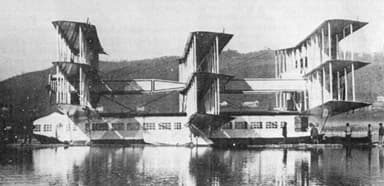
https://en.wikipedia.org/wiki/File:CaproniCa.60.jpg
The Caproni Ca.60 ‘Transaero’ boasted eight engines, and three sets of triple wings. Although Italian aviation pioneer Gianni Caproni only built one example, it managed a few hops when it first attempted to fly on February 12, 1921. But on March 4, 1921 it crashed on the water surface disturbed by a powerboat wake, and broke up upon impact.
The sets of three wings were made from the same lifting surfaces as the triplane bomber Caproni Ca.4. Pitch and roll were achieved using ailerons on the fore, aft, port and starboard surfaces, with Gianni Caproni claiming these could be managed ‘with just one hand on the controls’ using a patented device.

https://en.wikipedia.org/wiki/File:Ca.60_under_costruction.jpg
The specification of the Transaero Caproni Ca.60 was as follows:
- Length 74 ft, height 31.5 ft, wing span 30.5 ft, wing area 8,100 sq ft
- Empty weight 30,865 lb, max take off 57,320 lb, crew 8, 100 passengers
- Eight Liberty L-12 V-12 water-cooled piston engines, 400 hp each
- 4-bladed fixed-pitch propellers, cruise speed 81 mph, range 380 mi
FEBRUARY 1921
French pilot, Adrienne Bolland sets an altitude record of 15,910 feet as she flies a demonstration Caudron G.3 off Buenos Aires
MARCH 1921
The German Junkers K 16 Micro Airliner
The Junkers K 16 first flew on March 3, 1921 when it performed satisfactorily. However, the small airliner had to be mothballed, and stored after the Allies forbade all aircraft production in Germany. The aircraft was a conventional, high-wing cantilever monoplane of all-metal construction, equipped with fixed and tailwheel undercarriage.

https://en.wikipedia.org/wiki/File:Junkers_K_16.jpg
The pilot of the micro airliner sat in an open cockpit, while the two passengers were provided with an enclosed cabin within the fuselage. Junkers stored the prototype securely at its Dessau factory. However, progress had largely passed it over, by the time restrictions were lifted in 1924, although Junkers did manage to sell 17 examples, mostly to private owners.
The specification of the Junkers K 16 was as follows:
- Length 26 ft, height 9 ft, wing span 36 ft, wing area 178 sq ft
- Empty weight 950 lb, gross weight 1,890 lb, crew one, two passengers
- Siemens-Halske Sh 4 , 65 hp air-cooled radial engine
- Max speed 91 mph, range 375 miles, endurance not known

https://en.wikipedia.org/wiki/File:Awionetka_Junkers_K16_NAC_1-S-1105-1.jpg

https://en.wikipedia.org/wiki/Junkers_K_16#/media/File:Junkers_K16,_skica_(Letectv%C3%AD,_August-September_1925).jpg
APRIL 1921
Pioneer aviator Bert Hinkler sets a new world endurance record by flying an Avro Baby 800 miles non-stop from Sydney to Bundaberg, Australia in 8 hours 40 minutes.
Norwegian Marinens Flyvebaatfabrikk M.F.6 Biplane Float Plane
The Marinens Flyvebaatfabrikk M.F.6 marked the swansong of pusher technology for the Royal Norwegian Navy Air Service, as far as the aircraft factory was concerned. But it was only a stop gap solution, as they explored forward-facing propellers that pulled the aircraft through the air.
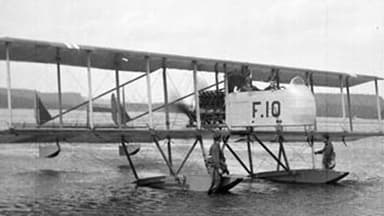
http://www.airwar.ru/enc/other1/marinensmf6.html
Marinens Flyvebaatfabrikk produced only two of the stop-gap trainers, that the Royal Norwegian Navy Air Service urgently needed to replace its troublesome M.F.4 airplanes. Power came from a Beardmore 160 hp engine, imported from United Kingdom.
The specification of the Marinens Flyvebaatfabrikk M.F. 6 trainer was as follows:
- Length 33.5 ft, height 11.5 ft, wing span 51 ft, wing area unknown
- Empty weight 2,271 lb, gross weight 2,932 lb, crew two
- Beardmore 160 hp 6-cyl. water-cooled in-line upright piston engine, 160 hp
- Max speed 75 mph, cruise 56 mph, range 110 mi, climb 327 ft per minute

https://en.wikipedia.org/wiki/Beardmore_160_hp#/media/File:Beardmore_160HP.JPG
MAY 1921
French airline Société Générale de Transports Aérien (SGTA) extends its Paris-Brussels route to Amsterdam, using Farman F.60 Goliaths on the route.
Italian ace Giovanni Ancillotto flies across the Andes in Peru, traveling from Lima to Cerro de Pasco in an Ansaldo A.1 Balilla in 1 hour 35 minutes. He reaches a maximum altitude of 22,966 feet, and flies from Lima to La Oroya at an average speed of 143 mph.
Belgian airline Société Nationale pour l’Etude des Transports Aériens (SNETA) opens a Brussels-London Croydon Airport route using Farman F.60 Goliaths.
United States Boeing GA-1 Armored Triplane Attack Aircraft
The Boeing GA-1 was an armored triplane, with a pair of modified Liberty engines driving pusher propellers. It was intended to strafe troops on the ground, while being able to defend itself from air attack. However, the armor covering the front half of the fuselage, and the engine housings increased the weight to five tons and in the end only ten were made.

https://en.wikipedia.org/wiki/File:Boeing_GA-1_on_ground.jpg
The U.S. Army had decided to explore highly armored, and armed specialist ground-attack aircraft. There were no takers for the proposal, and so the engineering department attempted what the aviation industry clearly considered impossible. For it, fields of fire were more important than aerodynamic cleanliness but Boeing was up for the challenge.
The sturdy structure was designed to lift 2,200 lb of armor plate, plus a heavy bomb load. The pilot sat in a semi-enclosed cockpit controlling four machine guns poking through armored shutters.
Two more machine guns fired forward and upward over the wings, while a further two fired to the rear, and downwards through a fuselage tunnel. There was also a single machine gun up and over the wings.
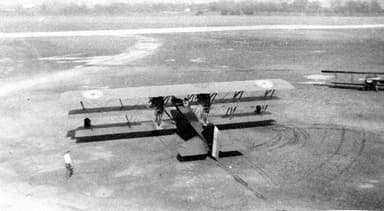
https://en.wikipedia.org/wiki/File:Boeing_GA-1_top.jpg
The Boeing GA-1 ground attack aircraft was not a success. It had poor visibility and performance, particularly in rate of climb, maneuverability and range, and was generally rated a failure. Pilots disliked the aircraft so intensely it’s said they were made to fly them for disciplinary infractions.
The specification of the Boeing GA-1 was as follows:
- Length 33.5 ft, height 14.5 ft, wing span 65.5 ft, wing area 1,016 sq ft
- Empty weight 7,834 lb, gross weight 10,426 lb, crew three
- Two Liberty L-12A water-cooled V12 pusher engines, 435 hp each
- Max 105 mph, cruise 95 mph, range 350 mi, ceiling 11,500 ft, climb 600 ft per min
- One 37 mm Baldwin cannon, eight 0.30 cal. Browning machine guns
- Ten small fragmentation bombs with some machine guns removed

https://en.wikipedia.org/wiki/File:Liberty_L-12-1.jpg
JUNE 1921
The Boeing Company secures an order from the U.S. Army to build 200 Thomas-Morse MB-3 fighters.
The United States Army conducts the first experiments in cabin pressurization using a de Havilland DH.4.
French Blériot-SPAD S.46 Five-Passenger Biplane
The Blériot-SPAD S.46 was a small French airliner with a successful flight record. It was a conventional biplane – derived from the Blériot-SPAD S.33 – that seated four passengers in an enclosed cabin, while the pilot and occasionally a fifth passenger rode in an open cockpit.

https://en.wikipedia.org/wiki/File:Bleriot-SPAD_S.46.jpg
The Blériot-SPAD S.46 took its first flight on June 16, 1921 and proved a success. However, SPAD continued to experiment with different engines. The factory produced approximately 40 of the airplanes, of which the Franco-Roumaine airline purchased 38 for use on their continental European routes.

https://commons.wikimedia.org/w/index.php?search=SPAD+S.46&title=Special%3ASearch&go=Go&ns0=1&ns6=1&ns12=1&ns14=1&ns100=1&ns106=1#/media/File:Bl%C3%A9riot-SPAD_S.66_F-FRER_CIDNA_-_LBS_SR03-04010.tiff
The specification of the Blériot-SPAD S.46 was as follows:
- Length 29.5 ft, height 10.5 ft, wing span 41.4 ft, wing area 510 sq. ft
- Empty weight 3,124 lb, gross weight 5,005 lb, crew one, five passengers
- Lorraine-Dietrich 12Da V-12 water-cooled piston engine, 370 hp
- Max speed 133 mph, range 500 mi, ceiling 16,570 ft, climb 530 ft/min
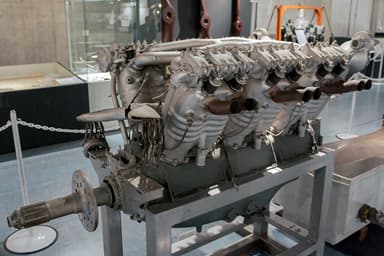
https://en.wikipedia.org/wiki/Lorraine_12D#/media/File:Lorraine_400hp_aircraft_engine_front-left_2010_The_Sky_and_Space.jpg
JULY 1921
United States Army Air Service Martin NBS-1 bombers sink the decommissioned German battleship Ostfriesland to demonstrate the power of aircraft to destroy large warships.
AUGUST 1921
United States Curtiss CR-Series Biplane Racers
The United States Navy decided it wanted a racing aircraft in August 1921. Curtiss responded with the Curtiss CR that won competitions and spun out into several other low production versions. There were two similar land planes, namely the Curtiss CR-1 and Curtiss CR-2.

https://en.wikipedia.org/wiki/File:Curtiss_CR-1_with_B_Acosta_1921.jpg
The Curtiss CR was a conventional single-seater biplane with a monocoque fuselage, and staggered single-bay wings of equal span braced with N-struts. However, its ‘secret weapon’ was an exceptionally powerful 475 hp Curtis V-12 engine.
The Curtiss CR-1 and its stablemate CR-2 won several significant competition trophies, including breaking the world speed record several times. There were also racing seaplane models which triumphed in competitions.
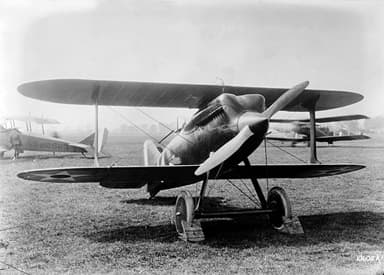
https://en.wikipedia.org/wiki/File:Curtiss_R-6_racer.jpg
The specification of the CR-3 seaplane was as follows:
- Length 25 ft, height 10.5 ft, wing span 22.5 ft, wing area 168 sq ft
- Empty weight 2,119 lb, gross weight 2,746 lb, crew one
- Curtiss D-12 5PL V-12 water-cooled piston engine, 475 hp
- Max speed 194 mph, range 281 mi, service ceiling 22,000 ft

http://www.aviation-history.com/engines/d12.htm
SEPTEMBER 1921
Colombian airline SCADTA begins the first regular scheduled airline service in Latin America, operating float-equipped Junkers F.13s between Barranquilla and Girandot, Colombia.
Lieutenant John A. Macready sets a new world altitude record of 34,508 feet piloting a United States Army Air Service Packard-Le Peré LUSAC-11 fighter.
OCTOBER 1921
British Avro Aldershot 547 Single-Engine Heavy Bomber
The Avro Aldershot 549 was a three-bay biplane with steel-framed fuselage structure, plywood and fabric covering, and wooden wings. It was made in response to a Royal Air Force request for a heavy long-range day and night bomber, to be powered by a Rolls-Royce Condor engine.

There were three crew members aboard the Aldershot 549, of which seventeen aircraft were made. The pilot and navigator sat side by side in an open cockpit, with a separate cabin inside the fuselage for the latter, who was also the bomb aimer. The gunner sat in a separate cockpit behind the wings.
Avro lengthened the fuselage by six feet after the first flight in October 1921, to improve directional stability. After experiments with alternative engines the Aldershot 549 entered service in 1924. However, it only served for a short time before the Air Ministry decided heavy bombers should have multiple engines, and the Handley Page Hyderabad replaced it in January 1926.

https://en.wikipedia.org/wiki/File:Avro_549C_Aldershot_IV_L%27Air_February_15,1927.jpg
The specification of the Avro Aldershot 549 Type III was as follows:
- Length 45 ft, height 15 ft, wing span 68 ft, wing area 1,064 sq ft
- Empty weight 6,310 lb, gross weight 10,950 lb, crew three
- Rolls Royce Condor III V-12 liquid-cooled piston engine, 650 hp
- Max speed 110 mph, cruise 92 mph, range 625 mi, ceiling 14,500 ft
- One 0.303 inch Lewis Gun in rear cockpit for gunner
- Provision for vertical and forward flying Vickers machine guns
- Up to 2,000 pound weight of bombs carried internally or externally
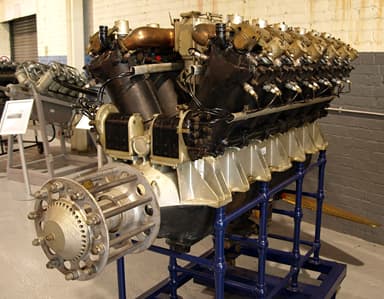
https://en.wikipedia.org/wiki/Rolls-Royce_Condor#/media/File:Rolls-Royce_Condor_III_RRHT_Derby.jpg
Japanese Mitsubishi 1MF Carrier Aircraft
British aircraft designer Herbert Smith, previously with Sopwith Aviation Company designed the Mitsubishi 1MF – also known as the Navy Type 10 Carrier Fighter – for the Imperial Japanese Navy in the early 1920’s. Smith and a team of British engineers then assisted Mitsubishi Internal Combustion Engine Manufacturing Co Ltd to produce the aircraft.
https://en.wikipedia.org/wiki/File:Mitsubishi_1MF3A.jpg
The Mitsubishi 1MF, of which Mitsubishi produced 138, was a single-seat, single-bay biplane with unequal-span wings, and all-wooden construction. It benefited from claw-type arrestor gear for use with British-style fore and aft arrestor cables, and became the first aircraft to take-off from and land on Japan’s new aircraft carrier Hōshō on 28 February 1923.
The specification of the Mitsubishi 1MF was as follows:
- Length 22.5 ft, height 10 ft, wing span 28 ft, wing area unknown
- Empty weight 2,072 lb, gross weight 2,882 lb, crew one
- Mitsubishi Hi V-8 water-cooled piston engine (Hispano-Suiza 8), 300 hp
- Max 132 mph, endurance 2.5 hrs, ceiling 23,000 ft, climb 10,000 ft / 10 min
- Armament two 0.303 inch machine guns.

https://commons.wikimedia.org/w/index.php?search=Mitsubishi+1MF+&title=Special%3ASearch&go=Go&ns0=1&ns6=1&ns12=1&ns14=1&ns100=1&ns106=1#/media/File:Hosho_first_landing_-_1MF3.jpg
Polish Potez XV Observation Biplane
The Potex XV was a licensed version of the French SEA IV single-engine, two-seat observation biplane fighter. This first flew in France in 1921, although it was two years before Polish production reached maturity.

https://commons.wikimedia.org/wiki/File:Airplane,_airport,_hangar,_biplane_Fortepan_14244.jpg
The Potez XV version of the SEA IV fighter was similarly a conventional biplane, with fixed tailskid landing gear and a nose-mounted 370 hp engine. Potex manufactured 135 of these in Poland. They served in observation roles before being superseded in 1927, and redeployed as trainers until the mid-1930s.

https://commons.wikimedia.org/wiki/File:Potez_XV_L%27A%C3%A9ronautique_December,1922.jpg
The specification of the Potez XV was as follows:
- Length 28.5 ft, height 10.5 ft, wing span 41.5 ft, wing area 500 sq ft
- Empty weight 3,278 lb, gross weight 4,299 lb, crew two
- Lorraine-Dietrich 12Db W-12 water-cooled piston engine, 414 hp
- Max speed 126 mph, range 320 mi, ceiling 13,800 ft, climb 770 ft / min

https://en.wikipedia.org/wiki/Lorraine_12D#/media/File:Lorraine_400hp_aircraft_engine_front-left_2010_The_Sky_and_Space.jpg
NOVEMBER 1921
British Westland Walrus Spotter-Reconnaissance Biplane
The Royal Navy developed an urgent need for a reconnaissance / spotter airplane in 1919. Airco accepted the challenge first but failed to perfectly meet requirements. Westland Aircraft took the project over using partly completed Airco DH.9A airframes.

https://en.wikipedia.org/wiki/File:WWalrus.jpg
The Westland Walrus that emerged was a single-engine, two-bay biplane modified from the earlier attempt by Airco to meet Royal Navy requirements. Thirty-six were manufactured and commissioned into service in a Royal Air Force squadron in late 1921.
The observer / radio operator sat behind the pilot’s open cockpit, but also had a prone position for observing directly below. The aircraft had provision for jettisoning the undercarriage, and ditching at sea using floatation bags and hydro vanes. However, the Royal Navy was disinterested, despite it having arrestor gear for landing on aircraft carriers.

https://alchetron.com/Westland-Walrus
The specification of the Westland Walrus was as follows:
- Length 29,5 ft, height 11.5 ft, wing span 46 ft, wing area 496 sq ft
- Empty weight 3,180 lb, gross weight 4,998 lb, crew two
- Napier Lion II W-12 water-cooled piston engine, 450 hp
- Max speed 124 mph, ceiling 19,000 ft, climb rate 950 ft / min
- Forward firing Vickers machine gun, 1 or 2 rear Lewis guns on scarff ring
DECEMBER 1921
West Australian Airways commences the first regular air services in Australia.
Edward “Eddie” Stinson and Lloyd W. Bertaud set a new un-refueled manned flight endurance record, remaining aloft in a Junkers-Larsen JL-6 for 26 hours 19 minutes 35 seconds.








